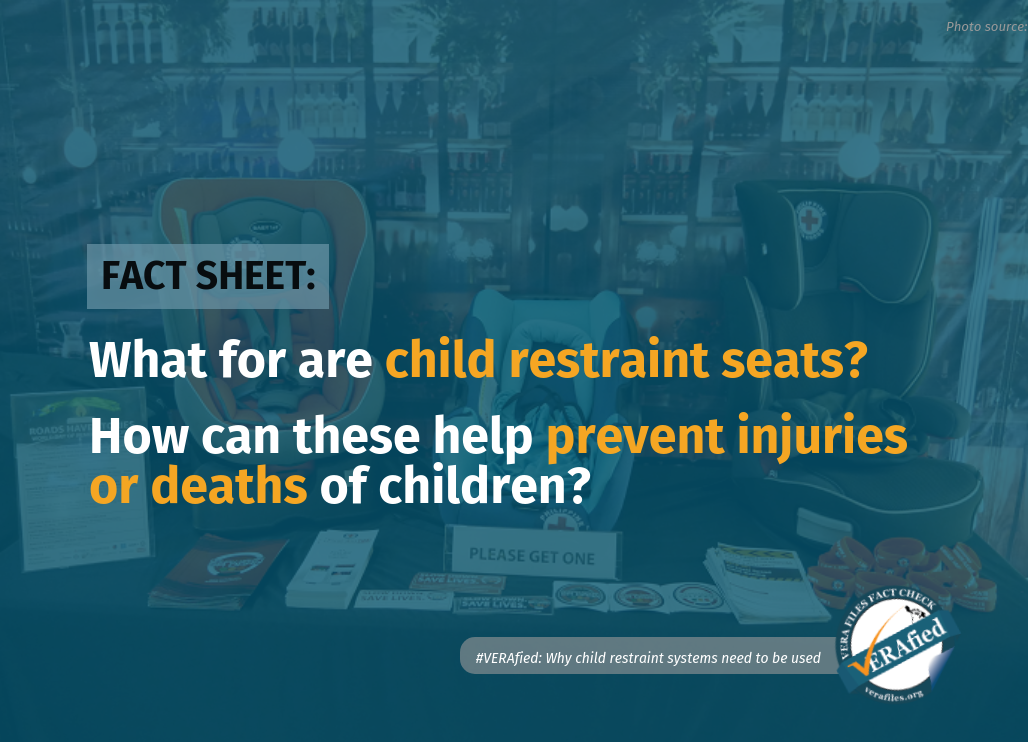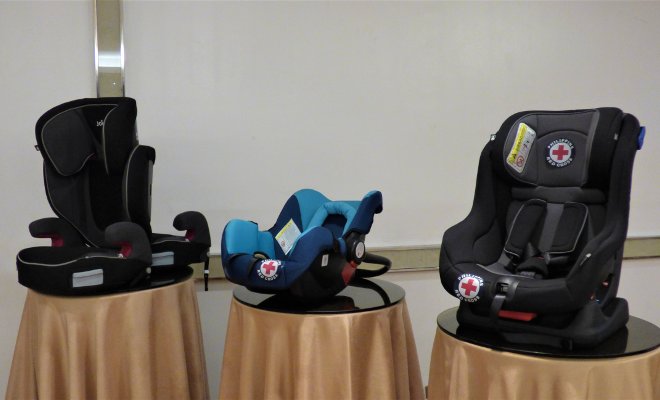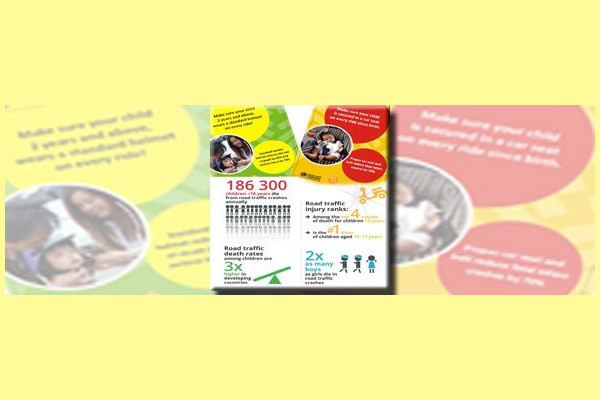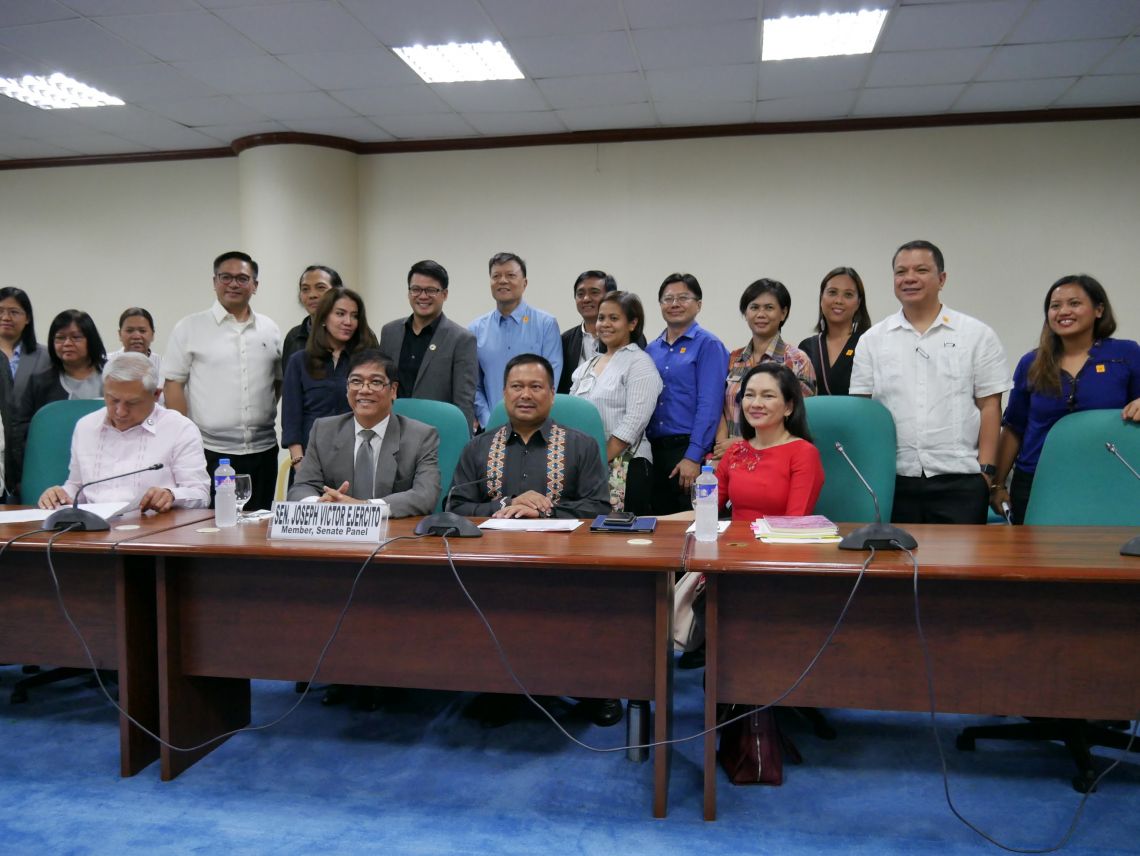Enforcement of the Child Safety in Motor Vehicles Act has been deferred to give car owners with children 12 years and younger time to install appropriate car seats specified in the new law.
Republic Act (RA) 11229 requires children up to age 12 and shorter than 150 centimeters or 59 inches (4 feet 11 inches) to be strapped to child restraint systems (CRS) or protective car seats during transport. It prescribes a fine ranging from P1,000 to P5,000 and one-year suspension of driving license for a violation.
The law, enacted in February 2019, was supposed to have been enforced last Feb. 2, more than a year following the approval of its implementing rules and regulations. On Feb. 11, President Rodrigo Duterte ordered the defermen of its implementation in view of the difficulties due to the coronavirus 2019 (COVID-19) pandemic, according to Presidential Spokesperson Harry Roque.
The Department of Transportation (DoTr) and the Land Transportation Office (LTO), the lead implementing agencies of the law, earlier agreed to suspend the penal provisions for six months in response to public criticisms and a call from senators for a review of some of its provisions.
However, the House committee on transportation resolved during a Feb. 10 hearing that it would need another law to suspend enforcement of RA 11229. Samar Rep. Edgar Sarmiento, the committee chairperson, instructed the secretariat to prepare a bill on this. He cited a Supreme Court ruling, saying that a Congress resolution cannot amend or repeal a law.
Amid the confusion, let us take a look at the rationale behind RA 11229 and what types of car seats meet the standards set in the law and are appropriate for your child.
Here are five issues you need to know about the Child Safety in Motor Vehicles Act:
1. More children and young adults die from crash-related injuries than from any other type of injury
The number of deaths and injuries involving children in road crashes has been increasing to an alarming level.
According to the Philippine Statistics Authority (PSA), an annual average of 671 children aged 14 and below died from 2006 to 2014 due to road crashes. (See Use of car seats to protect children now a law – Vera Files)
The LTO cited in its 2019 Road Safety Action Plan that road crashes are the leading cause of death for children and young adults aged five to 29. Sixty-five percent (65%) of road crashes are due to driver error.
Records from the Metropolitan Manila Development Authority’s (MMDA’s) Metro Manila Accident Reporting and Analysis System (MMRAS) showed the number of road crash incidents increased from 65,111 in 2005 to 116,906 in 2018, with an average of 320 cases a day in Metro Manila alone. Most of these cases involved the age range between 18 and 34 (7,322 cases) and 35-51 (4,080). Human error accounts for 94% of road crash incidents.
The 2019 MMRAS annual report showed that the number of road mishaps rose to a record high of 121,771 that year, indicating a year-on-year increase of 4.16%. Of these incidents, 373 resulted in the death of 394 persons. Among the victims of the recorded road crash incidents, 1,661 were from zero to 17 years old while 8,111 were aged 18 to 34, and 4,666 were in the 35-51 age bracket.
In Asia and the Pacific region, road crashes kill more than 730,000 people a year, which translates to one person killed every 40 seconds or 2,000 deaths a day, according to estimates from the United Nations Economic and Social Commission for the Asia and the Pacific (ESCAP).
The World Health Organization (WHO) 2018 Global Status Report on Road Safety estimates 1.35 million road traffic deaths every year, and injuries at 20 to 50 million, making road traffic injury the 8th leading cause of death worldwide.
The same report identified road crashes as the “leading killer” for children ages five to 14, and young adults between 15 and 29. Fifty-four percent of deaths include motorcyclists (28%), pedestrians (23%), and cyclists (3%). It estimates that death occurs on the road every 24 seconds.
The United States Centers for Disease Prevention and Control (CDC) said children aged five to nine years old are more likely to die from crash-related injuries. About 150 children aged zero to 19 are brought every hour to emergency departments for crash injuries.
To help prevent more injuries and fatalities, the WHO, in cooperation with concerned sectors and organizations, provides technical support to different countries to address risk factors leading to road crashes such as unsafe road infrastructure, speeding, and not wearing of seat belts and child restraints.
In 2011, the Philippines began with more initiatives such as the implementation of road safety policies aligned with the Philippine Road Safety Action Plan (PRSAP) 2011-2020, including the passage of a child restraint law and the updated PRSAP 2017-2022, to bring down road traffic-related deaths to zero.
2. The advantages of using child seats
The use of a child restraint system — a device capable of accommodating a child occupant in a sitting or supine position — has been found to reduce the risk of road crash deaths for infants by 70% and children aged one to four years old by 47% to 54%, according to the WHO Seat Belts and Car Restraints Manual. Studies have shown that the CRS helps reduce the risk of injury in the event of a collision or sudden stop of a vehicle.
The WHO encourages legislation requiring the use of child restraints, saying it can be an effective tool to reduce road traffic-related injuries. The Global Health Observatory (GHO) data showed that as of 2016, at least 85 countries have child restraint laws that prescribe standards based on age, weight, and height — factors that are deemed important in achieving effectiveness. Of these, only 33 countries meet the “best practice” criteria of having a law that applies an age, weight, or height restriction on children sitting in the front seat, and a national child restraint law based on age, weight, or height.
With RA 11229 enacted in February 2019, the Philippines has joined the list that meets the “best practices” criteria, but its full implementation remains uncertain for now.
Explaining the advantage of CRS over seat belts, lawyer Daphne Marcelo, a road safety policy associate at the public interest law group ImagineLaw that helped craft RA 11229’s IRR, said seat belts do not fit children well because of their smaller and undeveloped bodies. As a replacement for seat belts, Marcelo said CRS helps prevent injuries to a child by directing the crash forces to the strongest parts of the body such as shoulders and hips, and protects the head, neck, brain, and spinal cord from the impact.
“There’s that very real danger that, in case of a crash, the child will be ejected from the vehicle or hit the side or interiors of that vehicle, which may have sharp objects,” she said, adding that not even the embrace of a parent can shield a child from the crash impact in the absence of a car restraint. (See Car seats for kids required starting Feb. 2)
Two car seats (rear-facing and front-facing) undergo a crash test for child restraint seats by the New Car Assessment Program for Southeast Asian Countries (ASEAN NCAP).
Sections 4 and 5 of RA 11229 adds to the optimal use of CRS by adhering to the WHO recommendation that the back seat is the “safest place” for a child on board a vehicle. Under the law, children are prohibited from sitting in front of a vehicle if they are 150 centimeters or shorter even if they are wearing an adult seat belt. (See Motor vehicle law highlights children’s rights to proper care and safety)
“The position of children in either front or rear seats is also important as a higher risk for injury is associated with front-seating position,” according to the WHO Seat Belts and Child Restraints Manual.
However, the law exempts children from using CRS if it would put them in great danger during medical emergencies or when suffering from a medical, mental, psychological, developmental, psychiatric, disability or other conditions to be determined by the DOTr in consultation with the Department of Health.
3. Types and prices of CRS
According to the WHO child restraints manual, CRS has four main types, depending on the age, weight, and height of children: the rear-facing (also called infant car seat), child safety seat, booster seat, and booster cushion.
Because a CRS needs to be installed properly, the IRR for Section 16 of RA 11229 requires the LTO to have its own fitting stations and provide guidelines for the accreditation of private fitting stations such as CRS sellers, gasoline stations, and the Philippine Red Cross.
While RA 11229 was supposed to take effect last Feb. 2, several Filipino parents, including those without a car, have been using CRS for the protection of their children even before it was mandated by law. However, child car seats acquired prior to the effectivity of the law must be inspected to check for any damage or expiry and be cleared for further use by the LTO.
(See ‘Don’t leave it to fate,’ says actress advocate of child car seats – Vera Files and Why risk injury? Get your child a car seat – Vera Files)
Manufacturers, sellers, and distributors of newer child restraints must pass the prescribed safety standards and secure safety stickers from the Department of Trade and Industry-Bureau of Product Standards (DTI-BPS). DTI-BPS will issue the Philippine Standard (PS) Mark License to local and foreign manufacturers selling in the country, and the International Commodity Clearance (ICC) for imported child car seats.
While the DTI has yet to release the list of approved CRS brands and models, a study conducted in 2017 by the Institute of Health Policy and Development Studies in the University of the Philippines Manila (UP-IHPDS) revealed that the average market price of child restraints is at P5,000, an amount many consider as too expensive for ordinary Filipinos. (See ‘Expensive’ car seats main concern in child road safety bill)
To address concerns on affordability and accessibility, the DTI and the DOTr are tasked to develop or support measures that will help Filipinos comply with the use of child restraints. (See For mothers, peace of mind has no price tag)
4. Not all motor vehicles are required to have CRS
As of now, CRS are required only for private vehicles, which are classified as:
- privately owned;
- diplomatic and government-owned;
- vehicles for hire (requiring a franchise); and
- vehicles under long-term lease contracts and strictly for the lessees or authorized representative use only.
Under Section 9 of RA 11229, the DOTr must conduct a study within one year from February 2021 and report to Congress the feasibility of using CRS in public utility vehicles such as jeepneys, taxis, and buses.
In case the DOTr finds that child restraints are not suitable in public transport vehicles, the agency must recommend other safety measures and regulations “for the safe and secure transportation of children.”
5. Penalties for violation of RA 11229
Under Section 10 of RA 11229, any driver who allows a child without a CRS in a moving vehicle will be fined from P1,000 to P5,000 and one’s driving license suspended for one year following the third and succeeding violations.
The same fines would apply to drivers who let a child sit in front of a car, leave a child unaccompanied by an adult in the vehicle, and allow the use of child restraints without PS or ICC stickers, or that are substandard or expired. Those who tamper, forge, alter, and imitate the safety stickers will be fined from P50,000 to P100,000 per compromised CRS device, without prejudice to applicable penalties under RA 7394 or the Consumer Act of the Philippines.
It also prohibits manufacturers, sellers, retailers, importers, and distributors from selling, importing, distributing, donating, leasing, among other violative acts, substandard or expired CRS, or those with no safety stickers. Otherwise, they will be fined P50,000 to P100,000 for every violation.
RA 11229 allows the DOTr to review whether to adjust or increase the fines once every five years by an amount not exceeding 10% of the existing rates.
Sources
Land Transportation Office, JUST A FEW CLARIFICATIONS ON THE IMPLEMENTATION OF CHILD RESTRAINT SEATS (CRS) IN VEHICLES, Feb. 2, 2021
Deferment of RA 11229
- Rappler, No child car seats? DOTr says no fines amid pandemic, Feb. 2, 2021
- CNN Philippines, DOTR: No fines yet to vehicles without child car seat, Feb. 2, 2021
- Philstar.com, Implementation of child car seat law postponed, Feb. 3, 2021
GMA News, LIVESTREAM: House panel hearing on deferring implementation of PMVICs, child seats law – Replay, Feb. 10, 2021
Office of the Presidential Spokesperson, (statement on the deferment of RA 11229), Feb. 12, 2021
Land Transportation Office, Road Satetv Action Plan, Accessed Feb. 11, 2021
Top Gear, MMDA: Metro Manila averaged 49 road injuries, 1 fatality per day in 2018, May 31, 2019
Top Gear, MMDA statistics show 121,771 reported road accidents in 2019, Feb. 24, 2020
United Nations Economic and Social Commission for the Asia and the Pacific, ESCAP/74/2 Conseil économique et social, Jan. 9, 2018
Supreme Court, SUPREME COURT RULES IN FAVOR OF NURSES IN GOVERNMENT HEALTH INSTITUTIONS, Oct. 9, 2019
Official Gazette, Republic Act 11229
Department of Transportation, Implementing Rules and Regulations of RA 11229, Accessed Feb. 3, 2021
Philippine Statistical Authority, Land Transport Accidents, 2017
World Health Organization, Road traffic injuries. Feb. 7, 2020
World Health Organization, Philippine Road Safety Action Plan (PRSAP) 2011-2020, Accessed Feb. 3, 2021
ImagineLaw, Road Crashes in the Philippines, 2019
World Health Organization, Road safety leaders commit to reducing road traffic deaths and injuries in the Philippines. Oct. 5, 2019
Metropolitan Manila Development Authority, Metro Manila Accident Reporting and Analysis System, 2019
Metropolitan Manila Development Authority, Metro Manila Accident Reporting and Analysis System, 2018
World Health Organization, Seat-belts and child restraints, Accessed Feb. 3, 2021
Mind the Gap Communications, Press conference on RA 11229 or Child Safety in Motor Vehicles Act, Jan. 30, 2021
Department of Trade and Industry, DTI-BPS proposes Technical Regulation on Child Restraint Systems – BPS S&C; Portal, Nov. 14, 2019
Department of Trade and Industry, Department Administrative Order (DAO) No. 20-03 Series of 2020 – BPS S&C; Portal, Accessed Feb. 3, 2021
University of the Philippines Manila, CRS Study on Affordability Accessibility Philippines, 2017
Senate of the Philippines, Senate Resolution No. 633 (18th Congress), Feb. 2, 2021
Senate of the Philippines, Senate Bill No. 1971 (17th Congress), Accessed Feb. 4, 2021
(Guided by the code of principles of the International Fact-Checking Network at Poynter, VERA Files tracks the false claims, flip-flops, misleading statements of public officials and figures, and debunks them with factual evidence. Find out more about this initiative and our methodology.)





